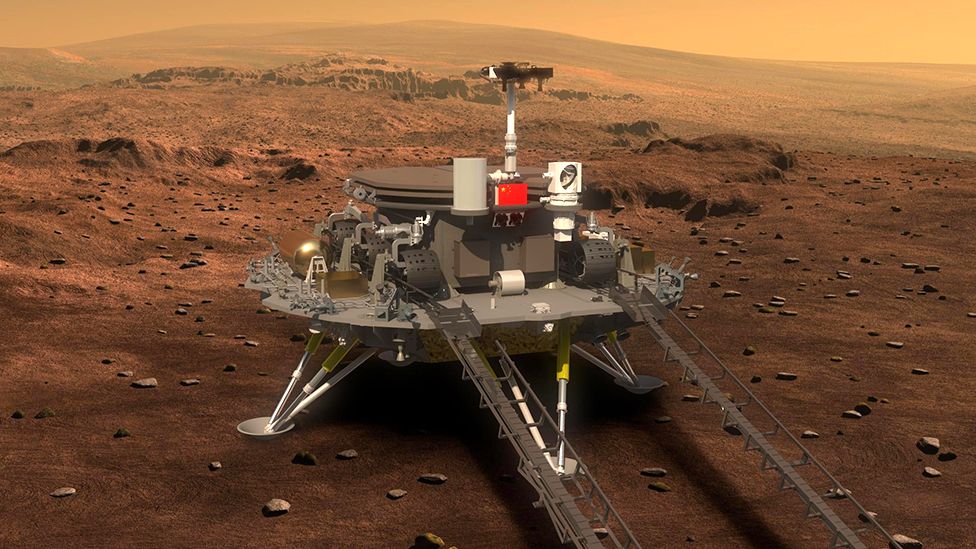China lands its Zhurong rover on Mars

London, May 15 (BBC): China has successfully landed a spacecraft on Mars, state media announced early on Saturday.
The six-wheeled Zhurong robot was targeting Utopia Planitia, a vast terrain in the planet's northern hemisphere. The vehicle used a combination of a protective capsule, a parachute, and a rocket platform to make the descent.
The successful touchdown is a remarkable achievement, given the difficult nature of the task. Only the Americans have really mastered landing on Mars until now. With this landing, China becomes the second country to put a rover on Mars.
Chinese President Xi Jinping congratulated the team's "outstanding achievement" in a special message.
"You were brave enough for the challenge, pursued excellence, and placed our country in the advanced ranks of planetary exploration," he said.
The probe officially landed at 07:18 on Saturday, Beijing time (Friday 23:18 GMT), according to state media.
It took 17 minutes to unfold its solar panels and send a signal back to Earth. Zhurong, which means God of Fire, was carried to Mars on the Tianwen-1 orbiter, which arrived above the planet in February.
The time since has been spent surveying Utopia, taking high-resolution images to pinpoint the safest place to put down. The aim with all such ventures is to pick a spot, as far as possible, that is devoid of imposing craters and large boulders.

This model shows Zhurong to have a similar look to Nasa's Spirit and Opportunity vehicles. Photo - Getty Images
Chinese engineers have to follow events with a time lag.
The current distance to Mars is 320 million km, which means radio messages take almost 18 minutes to reach Earth. Every stage of the Zhurong's approach to the surface, therefore, has to be managed autonomously.
The entry (into the atmosphere), descent, and landing strategy follow a familiar architecture. At the chosen moment, the rover, encased in an aeroshell, is released from the Tianwen orbiter and dives downwards.

The name's significance: Zhurong is the god of fire in ancient Chinese mythology. Photo - CNSA
A heatshield on the capsule slows the fall by pushing up against the Martian air. A parachute then opens to reduce the velocity still further. Finally, the robot breaks away on a rocket-powered bench for the manoeuvres that take it to the ground.
It is a daunting challenge, but China has shown great competence of late in its space endeavors, which have included putting two rovers on the Moon.
Now that Zhurong has got down successfully, scientists will try to get at least 90 Martian days of service out of it, studying the local geology. A day, or Sol, on Mars lasts 24 hours and 39 minutes.
The robot looks a lot like the American space agency's (Nasa) Spirit and Opportunity vehicles from the 2000s. It weighs some 240kg and is powered by fold-out solar panels.
A tall mast carries cameras to take pictures and aid navigation; five additional instruments will help assess the mineralogy of local rocks and look for any water-ice below ground.
Recent News

Do not make expressions casting dout on election: EC
14 Apr, 2022
CM Bhatta says may New Year 2079 BS inspire positive thinking
14 Apr, 2022
Three new cases, 44 recoveries in 24 hours
14 Apr, 2022
689 climbers of 84 teams so far acquire permits for climbing various peaks this spring season
14 Apr, 2022
How the rising cost of living crisis is impacting Nepal
14 Apr, 2022
US military confirms an interstellar meteor collided with Earth
14 Apr, 2022
Valneva Covid vaccine approved for use in UK
14 Apr, 2022
Chair Prachanda highlights need of unity among Maoist, Communist forces
14 Apr, 2022
Ranbir Kapoor and Alia Bhatt: Bollywood toasts star couple on wedding
14 Apr, 2022
President Bhandari confers decorations (Photo Feature)
14 Apr, 2022










